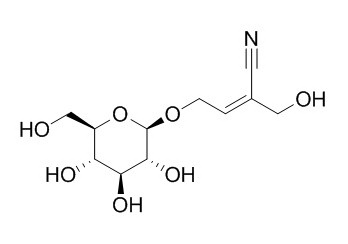Sarmentosin
Sarmentosin significantly lowers the SGPT level of patients suffering from chronic viral hepatitis, and shows a suppressive effect on cell-mediated immune responses in mice. It shows a good effect in lowering serum glutamate-pyruvate transaminase.
Inquire / Order:
manager@chemfaces.com
Technical Inquiries:
service@chemfaces.com
Tel:
+86-27-84237783
Fax:
+86-27-84254680
Address:
1 Building, No. 83, CheCheng Rd., Wuhan Economic and Technological Development Zone, Wuhan, Hubei 430056, PRC
Providing storage is as stated on the product vial and the vial is kept tightly sealed, the product can be stored for up to
24 months(2-8C).
Wherever possible, you should prepare and use solutions on the same day. However, if you need to make up stock solutions in advance, we recommend that you store the solution as aliquots in tightly sealed vials at -20C. Generally, these will be useable for up to two weeks. Before use, and prior to opening the vial we recommend that you allow your product to equilibrate to room temperature for at least 1 hour.
Need more advice on solubility, usage and handling? Please email to: service@chemfaces.com
The packaging of the product may have turned upside down during transportation, resulting in the natural compounds adhering to the neck or cap of the vial. take the vial out of its packaging and gently shake to let the compounds fall to the bottom of the vial. for liquid products, centrifuge at 200-500 RPM to gather the liquid at the bottom of the vial. try to avoid loss or contamination during handling.
Drug Des Devel Ther.2023, 17:2461-2479.
J Ethnopharmacol.2020, 260:112988.
Chung Shan Medical University2020, US20200323790A1
Molecules.2023, 28(2):727.
J Chromatogr B Analyt Technol Biomed Life Sci.2019, 1124:323-330
Molecules.2019, 24(1):E159
Food Control2022, 132:108434.
Journal of Herbal Medicine2024, 48:100950
Int J Mol Sci.2021, 22(19):10220.
Plant Biotechnol (Tokyo).2024, 41(3):267-276.
Related and Featured Products
J Chem Ecol. 2012 May;38(5):525-37.
Occurrence of sarmentosin and other hydroxynitrile glucosides in Parnassius (papilionidae) butterflies and their food plants.[Pubmed:
22527055]
Sequestration of plant secondary metabolites is a widespread phenomenon among aposematic insects. Sarmentosin is an unsaturated γ-hydroxynitrile glucoside known from plants and some Lepidoptera. It is structurally and biosynthetically closely related to cyanogenic glucosides, which are commonly sequestered from food plants and/or de novo synthesized by lepidopteran species. Sarmentosin was found previously in Parnassius (Papilionidae) butterflies, but it was not known how the occurrence was related to food plants or whether Parnassius species could biosynthesize the compound.
METHODS AND RESULTS:
Here, we report on the occurrence of Sarmentosin and related compounds in four different Parnassius species belonging to two different clades, as well as their known and suspected food plants. There were dramatic differences between the two clades, with P. apollo and P. smintheus from the Apollo group containing high amounts of Sarmentosin, and P. clodius and P. mnemosyne from the Mnemosyne group containing low or no detectable amounts. This was reflected in the larval food plants; P. apollo and P. smintheus larvae feed on Sedum species (Crassulaceae), which all contained considerable amounts of Sarmentosin, while the known food plants of the two other species, Dicentra and Corydalis (Fumariaceae), had no detectable levels of Sarmentosin.
CONCLUSIONS:
All insects and plants containing Sarmentosin also contained other biosynthetically related hydroxynitrile glucosides in patterns previously reported for plants, but not for insects. Not all findings could be explained by sequestration alone and we therefore hypothesize that Parnassius species are able to de novo synthesize Sarmentosin.



